


Charles Partleton (1839-1916)
Part II
This page is a continuation from Part I of the story of Charles Partleton. To view Part I, click here.
To summarise, Charles Partleton was born in 1839 in the vicinity of Drury Lane, circled in yellow in the map below.
During late 1846 or early 1847, Charles' mum & dad move south of the river to Lambeth, circled blue in the map below, where most of the rest of the Partleton family have already migrated over the previous 30 years.
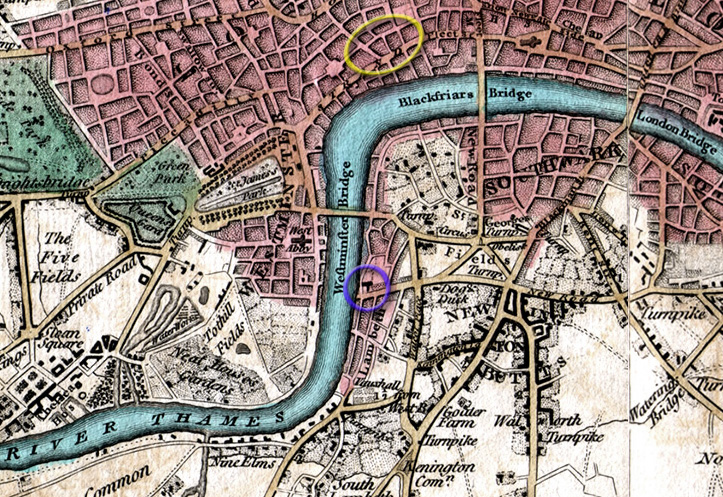
We know they have moved because Charles gets a new baby brother, John, who is christened at the church of St Mary-at-Lambeth.
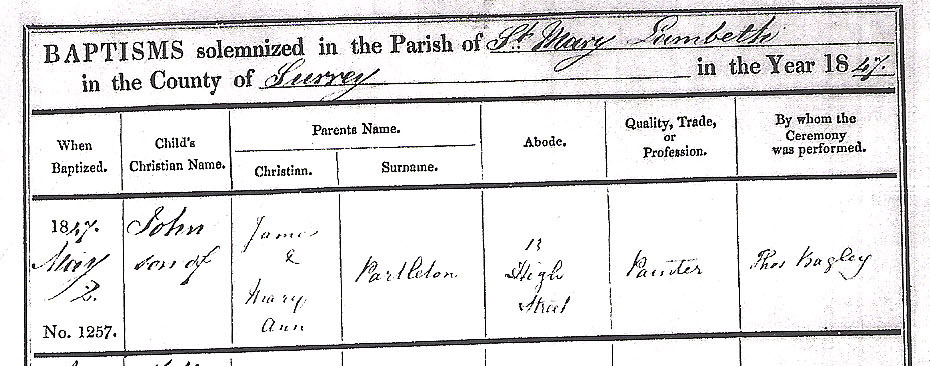
We see from the above baptismal entry that the family are living at 13 High Street. The High Street is mentioned several times in the Partleton Tree website, so I think it's time we had a really close look at it:

For the baptism of his brother John in 1847, 8-year-old Charles will have tagged along with his mum and dad up Lambeth High Street from their house (one of those shaded pink in the map above), a short walk of 100 yards or so, to St Mary's church at the top. Step into his shoes as we see the church, at an earlier date, but nonetheless as he would have seen it, from the viewpoint of the north end of the High Street (dark blue arrow in map):

Is that a dog pulling a cart at the left of the picture? Did they do that?
By 1849 the family have moved to Duke's Head Court, named after the Duke's Head pub on Lower Fore Street. The name of this little alley is different on every map and census: Cockets Alley, Coquets Alley, Cocketts Alley, Crookets Alley, Cockills Alley. Since it is called Crookets Alley in the map I'm using - shaded orange below - I will continue to refer to it as Crookets Alley:

The decision to move to move to Crookets Alley aka Duke's Head Court was to prove fatal for little Sarah Partleton:

As evidenced by the death certificate, signed with a cross by her mum, little Sarah died of the dread disease Cholera aged just 4 years and 4 months. There is so much to say about this, I've created for Sarah her own page on the Partleton Tree website even though she's only four.
Two years later, in the 1851 census, we find the family still residing in Crookets Alley; the enumerator has spelled it as Cockills Alley:
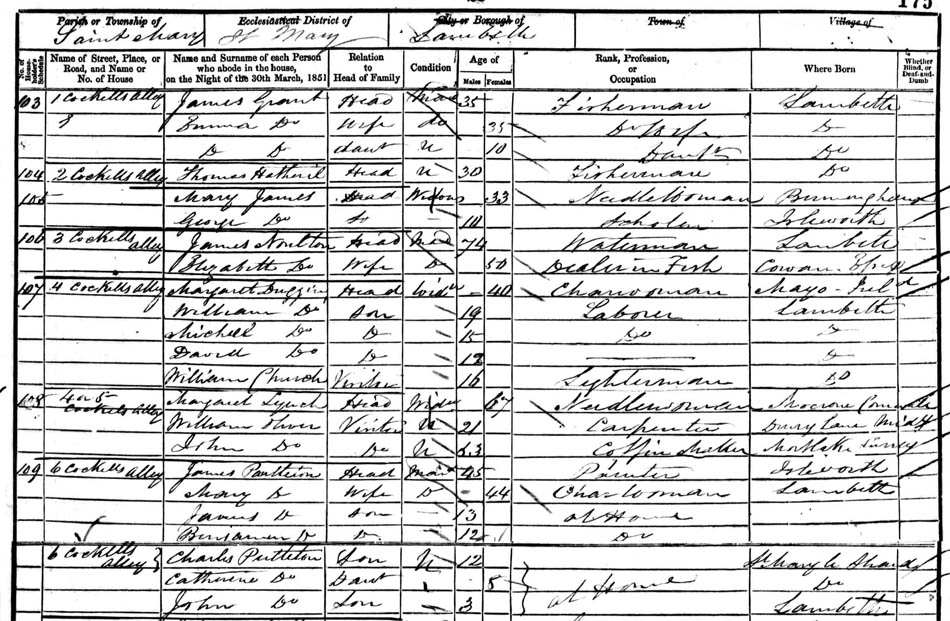
Charles' mum Mary Ann is pregnant at the time of the census, and a few weeks afterwards gives birth to George Partleton. Charles, aged 12, now has a little baby brother.
A reminder that Charles is in one of the houses shaded orange on the map below:

The houses in Crookets Alley are among the oldest houses in Lambeth. Below we see them in an earlier age, named as Cockets Alley in a 1720 map by John Stow:

And here we see Crookets Alley again - this time as as Coquet Alley - in the beautiful 1746 map of John Rocque:
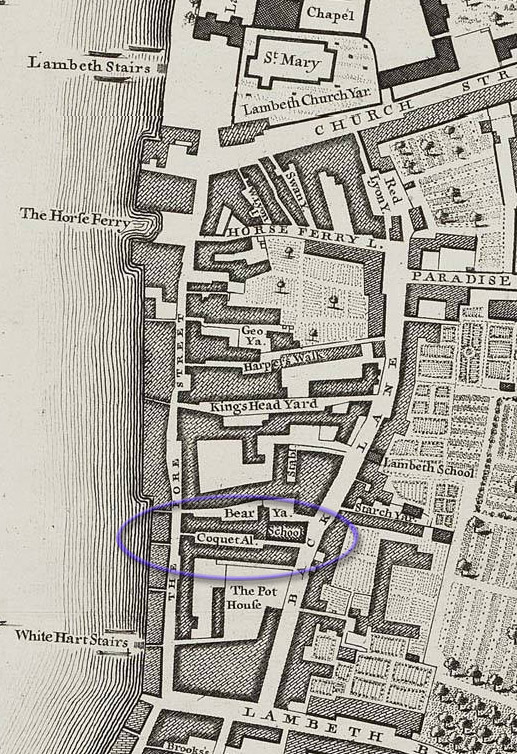
Note that the alley is right next to The Pot House. Potteries have been present in Lambeth since at least the 1500s and probably earlier. This Particular Pot House is later to become the premises of James Stiff potteries, and later still, one of Doultons many premises.
Lambeth Archive is a wonderful resource, and after much searching, I found this watercolour painting of 1850 of Crookets Alley. The artist is J. Findlay. One of these houses is the residence of Charles Partleton aged 12 in 1851:
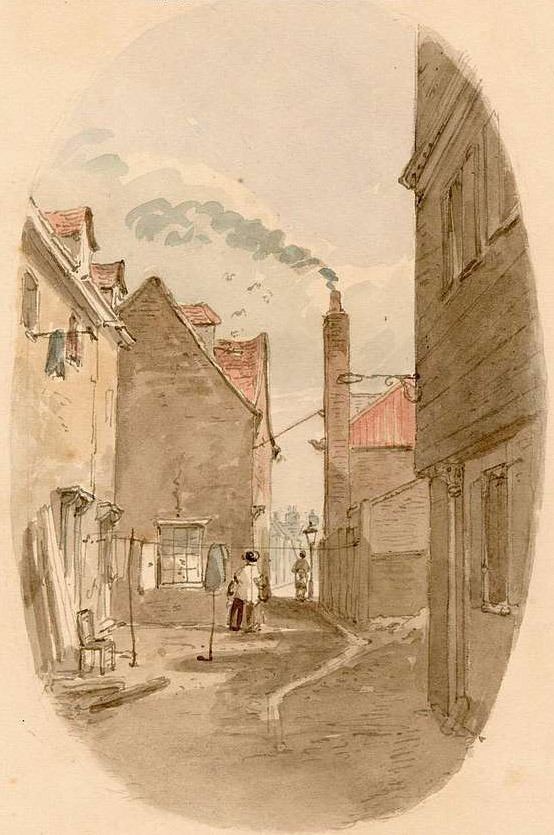
I'm wary of using watercolour illustrations; they always render a view of the world through rose-tinted glasses, which is fine unless one is painting rat-infested hell-holes. Having recorded the deaths on this web page of two little 4-year old girls, I'm not minded to be sentimental. Crookets Alley is an unsanitary slum with no sewer or fresh water and is in no way as charming as it may appear in the picture. People are dying of cholera in these very streets in 1848.

Just round the corner, literally yards away, we find the location of The Windmill Tavern, No. 44 High Street, shaded red on the map, seen in the photograph below from the viewpoint of the red arrow, looking directly north up Lambeth High Street. This amazing photograph was taken by photographic genius William Strudwick in c1860. Surely Charles' dad must have had a few pints in there... step into his shoes:
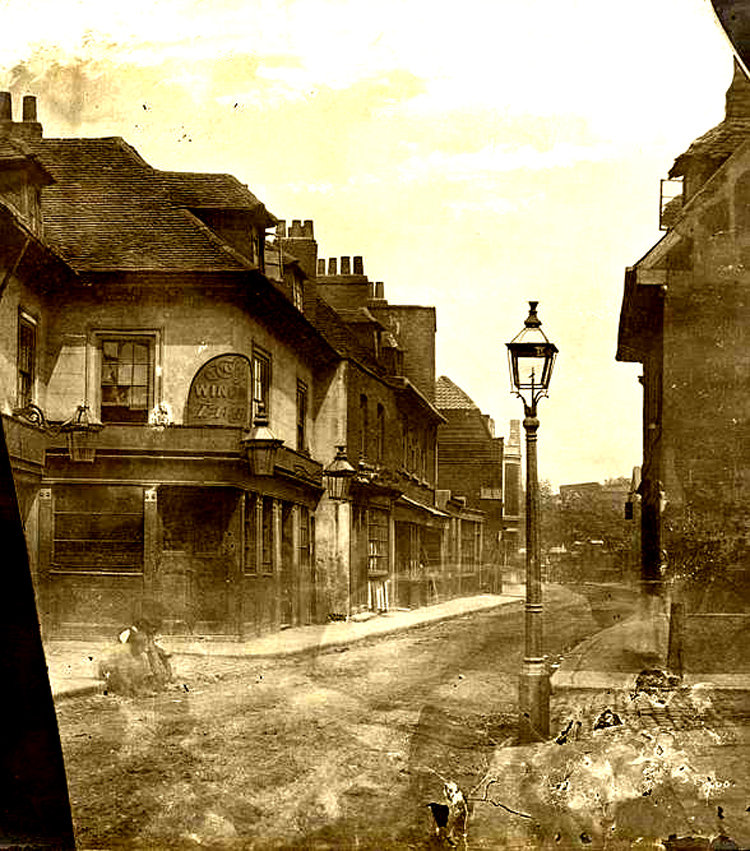

In c1870, the old Windmill Tavern [left] was demolished and replaced with a much less charming Victorian building which has miraculously survived the annihilation of the High Street of the 20th century, as we see on the right.
And we get almost exactly the same view in 1837, somewhat prettified, courtesy of watercolour artist Wilson, first name unknown:
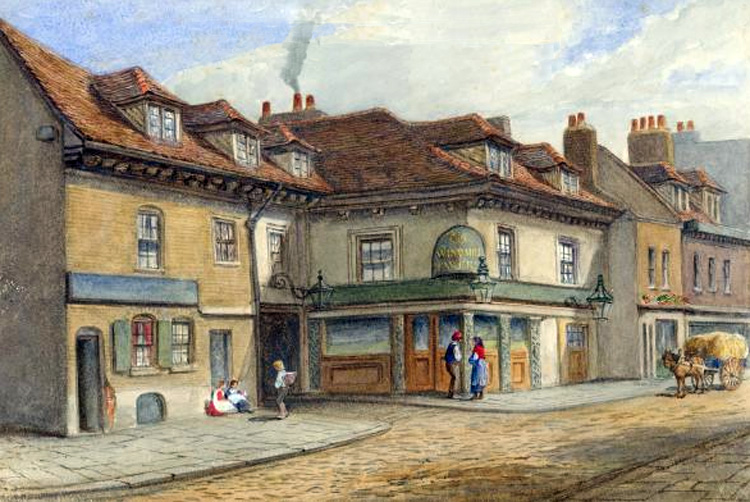
The entrance to Crookets Alley is clearly visible to the left of the pub. So..... whatever became of Crookets Alley?
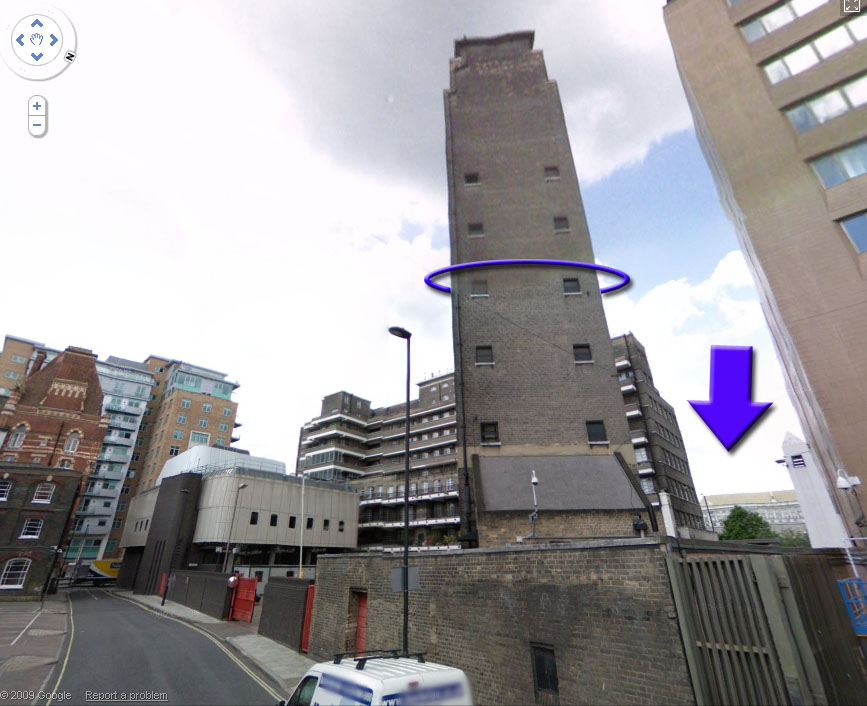
Having overlaid the 1799 map precisely over a modern map, I can reveal that Crookets Alley now lies under the surface of a car park at the point of the blue arrow in the photo above.
What's that strange tall tower ringed in blue? Well, the building directly behind it was the headquarters of the London Fire Brigade, and the tower was / is used for training firemen!
The picture above is seen from the green arrow in the [1799] map below, right next to the Windmill pub, shaded red. The future location of the tower is circled in blue:
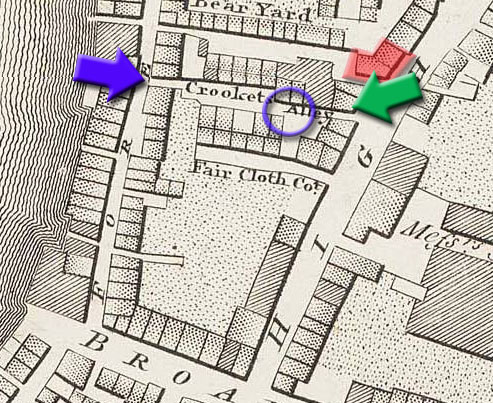
Here's the view from the modern Albert Embankment [formerly Fore Street], where we see the other end of Crookets alley from the blue arrow in the map above, thanks to Google Street View:

I think we should get Time Team to go dig up that car park!
The training tower is a Grade II Listed Building, so it will - for all practical purposes - be there for ever. Hey, ugly buildings need protection too!
How did we get from 1849 Crookets Alley to 1930s Art Deco Fire Brigade?...

A large area of the Lambeth foreshore was massively redeveloped in 1868 when Fore Street was replaced by the Albert Embankment. Here's what the foreshore of Upper Fore Street looked like to our Charles in 1848:

And, closer to Crookets Alley, here's a fantastic 1860s photograph of the Thames foreshore of Smith's Potteries on Lower Fore Street:
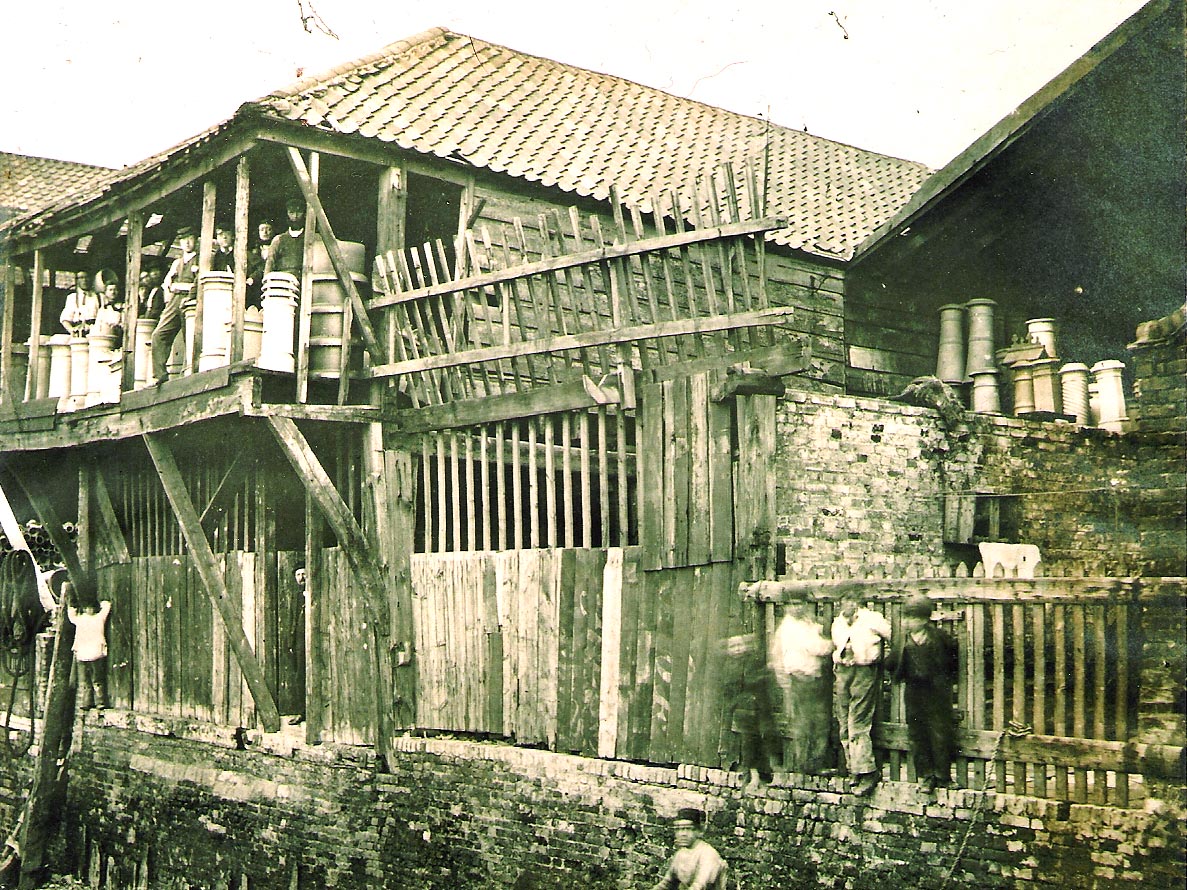
And here's what happened to Fore Street in 1868!

From the engraving above, where we are standing approximately at the viewpoint of the yellow arrow in the map below, it looks like Crookets Alley would not have survived this redevelopment. The Albert Embankment was a flood barrier, a slum clearance, a new main road; it included in its scope the construction of London's massive new sewer system, designed by the great Victorian engineer Sir Joseph Bazalgette, which would clean up the Thames of its disgusting effluent. There would be no more cholera:
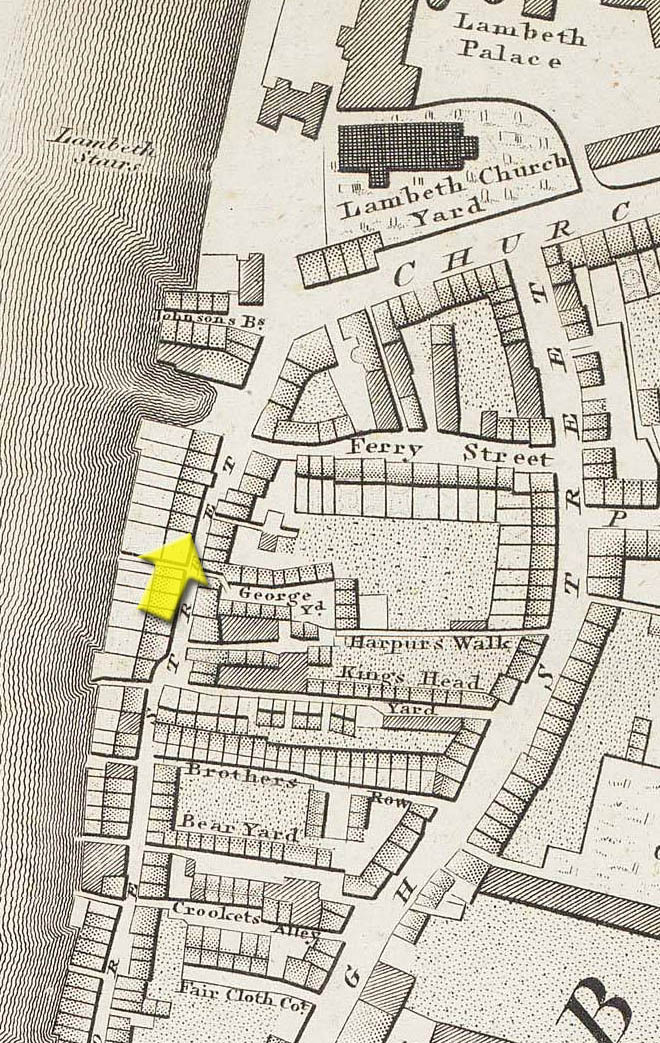
But if we look at the [unfortunately barely legible] Victorian plan for the work, the arc of the new embankment actually missed Crookets Alley - top right.
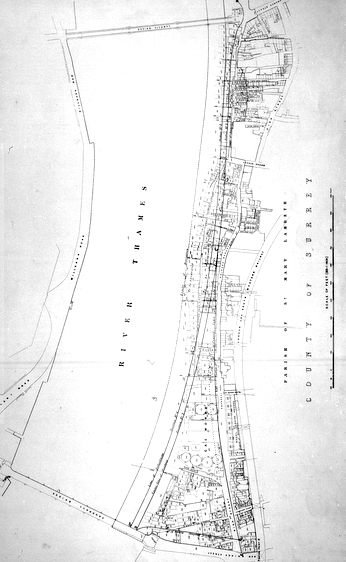
However, despite the fact that Crookets Alley is still there in the 1861 census, it's not there in the 1871 census.
This is because the whole block has been bought by Doulton's Pottery and redeveloped, which we see in a blurry plan of 1920 below. The circles are pottery kilns. The fuzzy words leaning backwards at top right say The Windmill Tavern - our little landmark!:
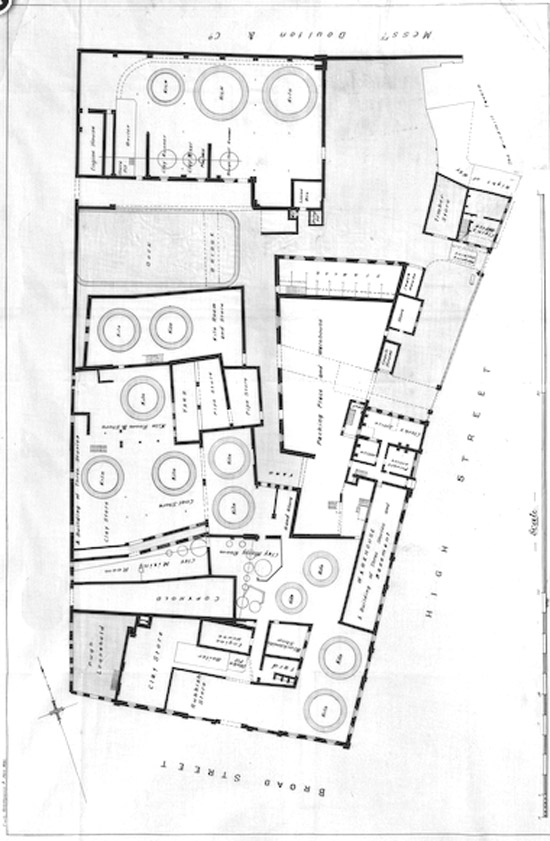
And if we overlay this plan on Horwood's map of 1799, we see what an exquisite job of cartography Richard Horwood had achieved:
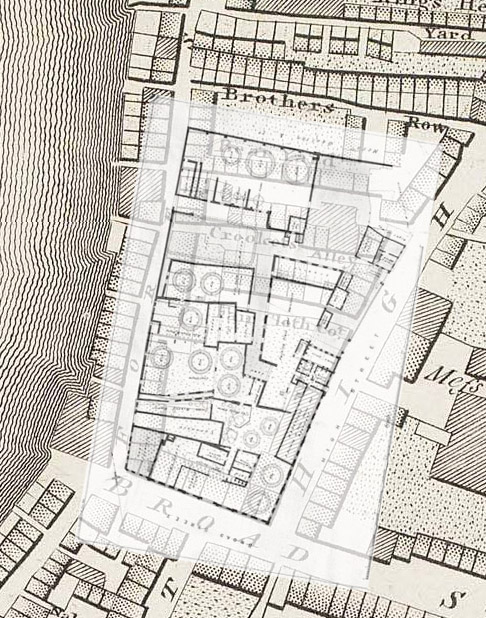
Reference this with the 1920 plan above & you'll observe that half of Crookets Alley now lies in the belly of Doulton's dock.

Doultons had more than one dock, so I couldn't swear that this one is the one we are talking about. But how did they get those barges in, with the new Albert Embankment in the way? Drag them across the road?
No, the Victorians weren't stupid... the barges went under the road as we see at the point of the blue arrow in the 1920s watercolour of the Lambeth Thames foreshore below:
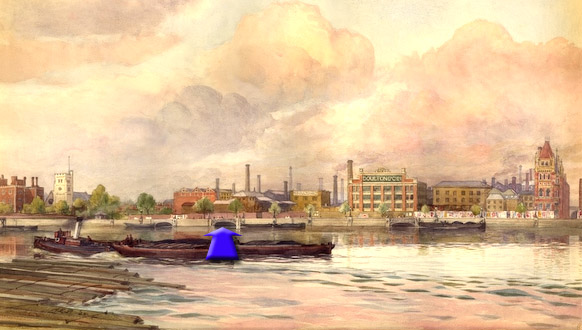
So from the 1860s onward, Crookets Alley is no more, and we clearly see in the picture above, the 'DOULTON & Co' sign signifying the new premises which replaced it.
But Doultons didn't last for ever.
In fact the building lasted just 70 years because in 1934 it was sold, demolished, and work commenced on the new London Fire Brigade Headquarters. Here's a picture of the work nearing completion on the on a smoggy, soggy, rainy day in August 1936. You may decide for yourself if the steeplejack is brave or just plain stupid:
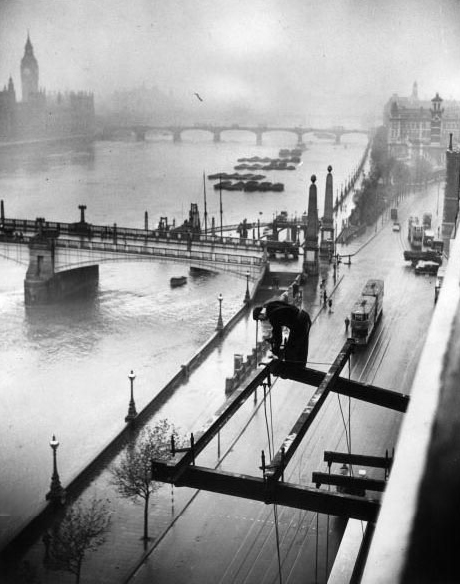
The trees at bottom left are still there, 75 years on.
And here's a photo of the completed job in a 1930s postcard:
The London Fire Brigade building also lasted just 70 years and it was sold in 2007, but will not be demolished.
As I write [May 2009], the property is being converted to luxury flats [which will have a jaw-dropping view over the Thames to the Houses of Parliament as witnessed in the steeplejack picture], and additional apartment blocks are to be built on the car park to make a courtyard in the middle which apparently will still be used by the Fire Brigade as a drill yard.
Here's one last view of the site of Crookets Alley, circled below in a modern satellite photo:

Let's get back to the High Street in 1848, and our Charles, who is 9 years old. He could be one of the street urchins on the left:

The above happens to be taken standing directly outside No 28 High Street, shaded in yellow below; the premises and home of John Doulton, whose potteries dominated the area.

In Victorian times, people really did literally 'live above the shop', as we see John Doulton circled in blue in the 1851 census below. His partner John Watts is living next door:

A reminder to any of our gentle readers who'd like to know where these census records come from, you'll find them in the extraordinary database of original scans held by Ancestry.co.uk. And if you're inspired by this website to seek out your own British ancestors as I have done, click here.
As a near neighbour for decades and presumably something of a local celebrity, the face of John Doulton may well have been recognisable to our Charles:
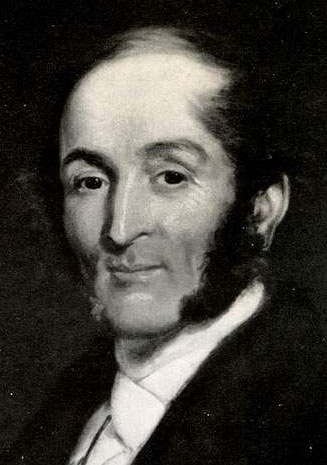
So let's have a few paragraphs about the man who created the famous Doulton brand... In 1815 soon after John Doulton had completed his apprenticeship as a potter in the village of Fulham, he invested his life savings of £100 in the Vauxhall Walk pottery of Martha Jones. Her foreman, John Watts, was also taken into partnership and the firm became known as Jones, Watts and Doulton. It specialized in industrial ware, brown stoneware, drainpipes as well as stoneware bottles for chemicals, beer, and other industrial liquids among others.
Martha Jones withdrew from the partnership in 1820 and the company moved to new premises at 15 Lambeth High Street in 1826.

In 1838, all houses on the High Street were renumbered, and No 15 became No 28 High street, where we see John living in 1851. In the same census sheet above, we see Doulton's partner John Watts living in the house next door, No 27.
By 1846, John Doulton's son Henry had set up an independent Lambeth Pottery which had become the leader in industrial products, particularly sanitation products. Following the retirement of John Watts in 1853, Doulton & Watts merged with Henry's company to become Doulton and Company. Doultons made lots of ceramic drainpipes, but also hand-decorated figurines, vases and dinnerware.
Doulton wasn't the only one who was making stoneware on Lambeth High Street:

In the image above we see No 39 High Street (shaded in pale green in the map), the premises of James Stiff (1808-1897), a former employee of Doulton. As we can see from the map, Charles' house in Crookets Alley is just behind the building on the right.

In the 1851 painting below, by artist J Findley, we get an even clearer view of James Stiff's pottery from the same viewpoint:

James Stiff was another one who liked to live above the shop as we see in the 1851 census below. One of those windows in the painting is his bedroom!

Stiff's pottery didn't just make drainpipes; much of their output was brown stoneware. Below we see a typical Stiff jug.

However, they did also make decorative pieces. Below we see two items made by Stiff:
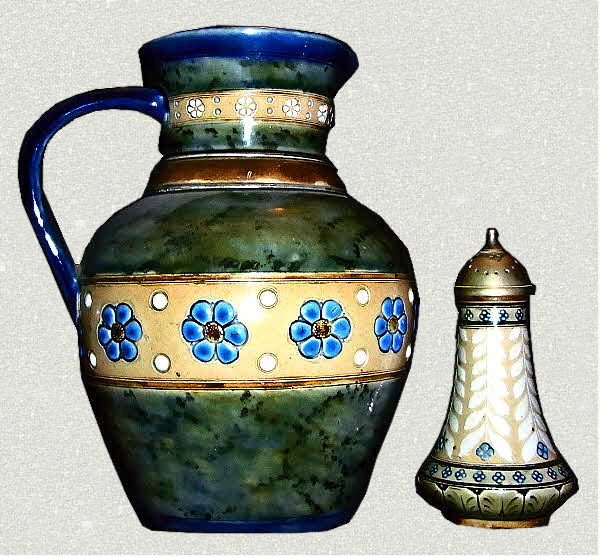 xxxxxx
xxxxxx
But business is business, and Stiff's premises were ultimately bought out by Doultons, as we saw earlier.
We need to get back to the story of Charles, and this page is getting too big, and Charlie is about to move away from home for a bit, so it's a good moment to continue this story on a new page.
Click here to continue with the story of Charles Partleton (1839-1916).
If you enjoyed reading this page, you are invited to 'Like' us on Facebook. Or click on the Twitter button and follow us, and we'll let you know whenever a new page is added to the Partleton Tree:
Do YOU know any more to add to this web page?... or would you like to discuss any of the history... or if you have any observations or comments... all information is always welcome so why not send us an email to partleton@yahoo.co.uk
Click here to return to the Partleton Tree 'In Their Shoes' Page.
